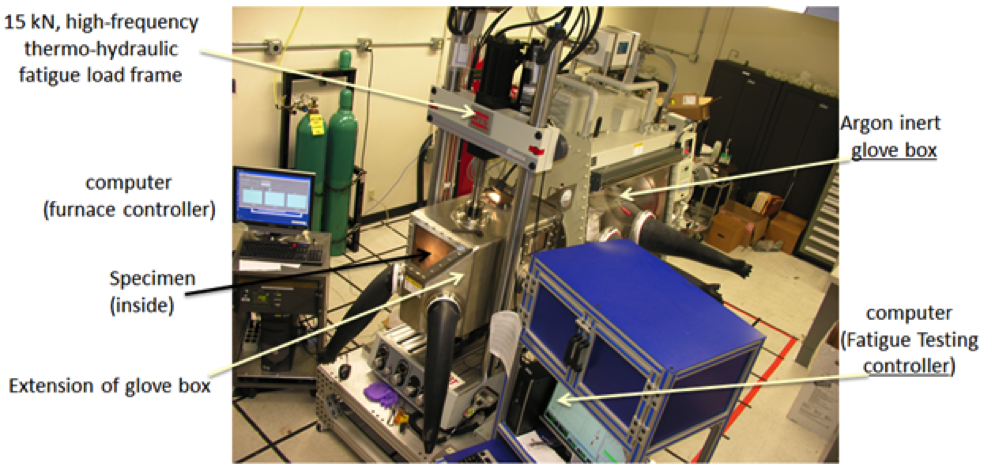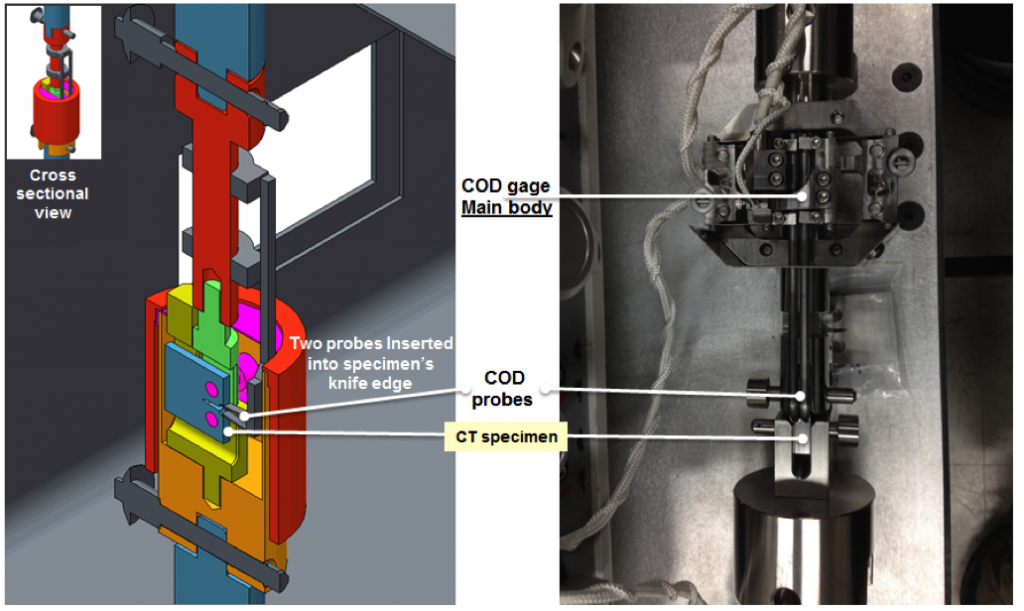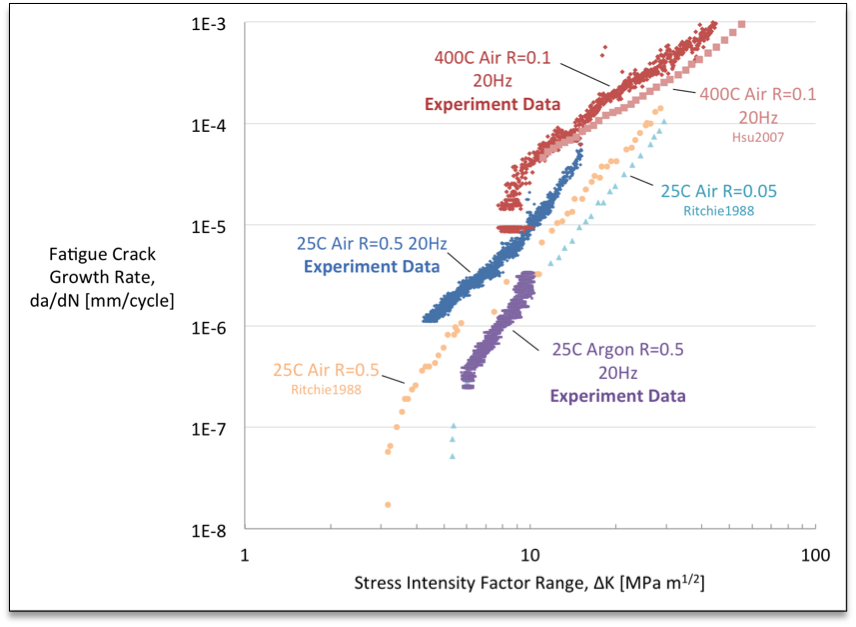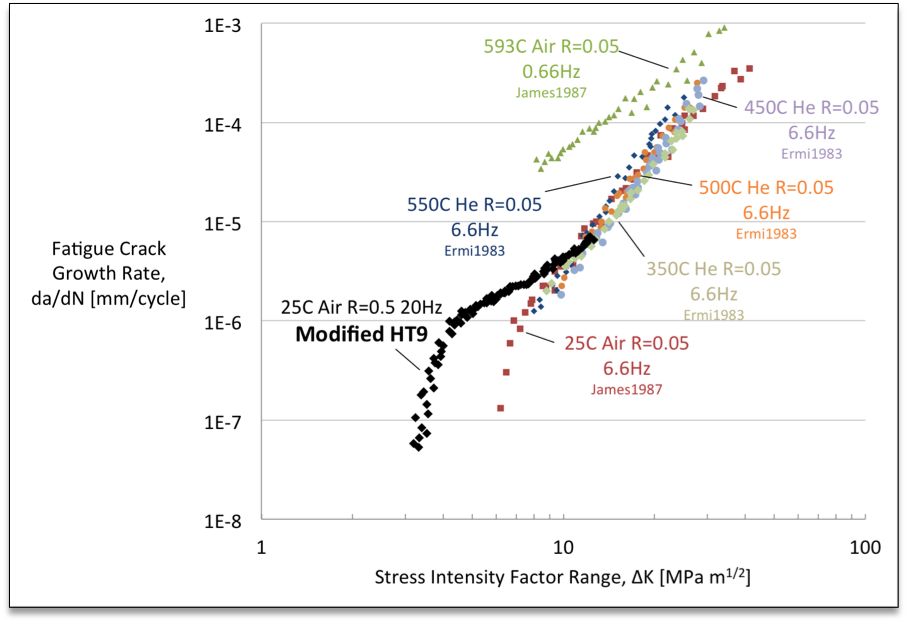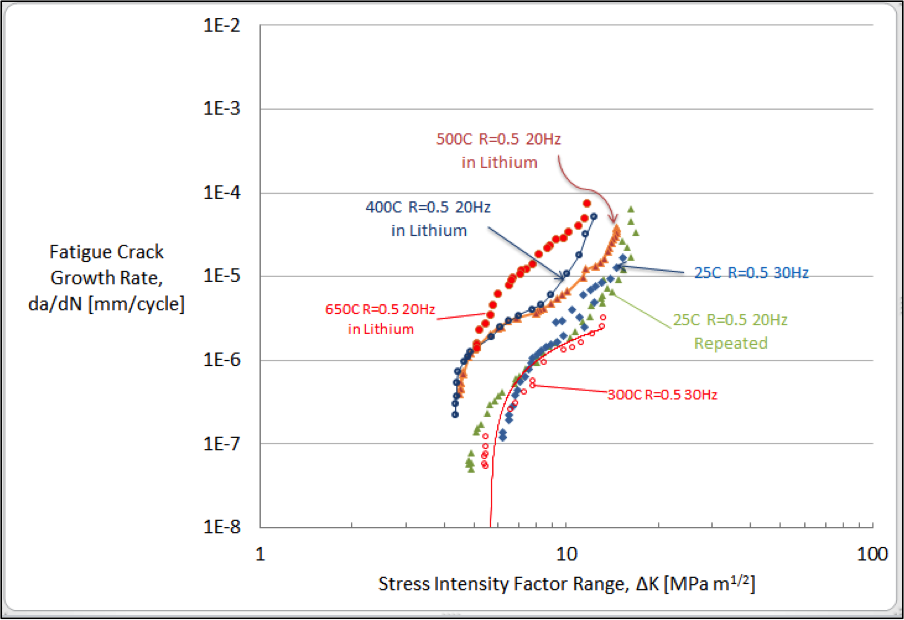B. William Choi (13-ERD-058)
Abstract
The objective of the study is to experimentally examine crack growth in structural steels proposed for future fusion chambers (particularly first walls). In this environment, the proposed materials would be subjected to cyclic fatigue while submerged in a high-temperature liquid-metal bath. A new mechanical testing facility was built that is capable of testing with loads/stress cycled at 10 to 50 Hz in liquid lithium up to 650oC. A limited number of fatigue crack-growth tests were conducted using compact tension specimens of two reduced activation ferritic/martensitic steels: Eurofer97 and modified HT9 steel. These were tested using the E647 standard test method for measuring fatigue crack-growth rates (issued by the standards organization ASTM International). Tests involved stress ratios of R = 0.1 (σmin/σmax= 0.1) and R = 0.5 cycled at 20 to 30 Hz under an argon inert environment while a compact tension specimen was submerged in molten lithium. This experimental facility provides a unique resource for future fusion and non-fusion research and development interests.
Background and Research Objectives
Our objective was to assess—quantitatively and in an accelerated manner—the effect of transient loads caused by thermal, pressure, and vibrational pulses on structural steels in an inertial fusion energy engine. Although the behavior of the steels is reasonably understood in steady-state conditions, the greatest threat to an inertial fusion energy engine will be a combination of thermally activated creep from high operating temperature and pulsed stresses from x rays, pressure waves, and subsequent surface cracks. Components may see over a billion cycles in their service lifetime, especially in Inertial Confinement Fusion.1 To enable such a long lifetime, we need a thorough understanding of the growth rate of fatigue cracks in metals even under exceedingly low cyclic stress intensities. While current research has documented the fatigue crack behavior of some steels at high temperature, little is known about those same cracks in the presence of liquid metals. The liquid lithium-based fluids for some breeder blanket concepts could potentially aggravate the damage from the fusion fluence and elevated temperatures. Understanding the impact of lithium on fatigue damage is critical to accurate prediction and tracking of these cracks. Our goal was to address this shortage of data by developing and performing cyclic, creep, and thermal pulse experiments in appropriate environments and at relevant stresses. Specifically, we focused on investigating the influence of liquid lithium on fatigue crack propagation in fusion-relevant steels at temperatures up to 650oC.
Fatigue fractures are the most commonly identified kinds of time-delayed fracture of structural materials. Such fractures occur when cracks grow under time-varying load conditions until a critical size is reached and the material fractures. The approach for determining fatigue failure is to model the growth of a fatigue crack directly using the crack-growth method, based on the empirical formula
where a is the crack length, N the number of loading cycles, da/dN is the crack-growth rate, C and m are constants derived from measured data, and ΔK is the stress intensity factor. There are many refinements of the method, but the most basic approach is to use crack-growth data under standard conditions and relate the conditions of interest to that data.2 For a given materials and stress ratio, the crack growth rates are a unique function of ΔK. The expression giving crack-growth rate can be integrated to determine how many cycles a structure will endure before a crack grows from some initial size (ai) to a final limiting size (af).
The objectives of this research were to assess the effect of transient loads from thermal, pressure, and vibrational pulses in the laser inertial fusion energy engine on reduced activation ferritic/martensitic structural steels, a class of structural materials that have improved irradiance resistance and have long been considered as the most promising candidate structure materials for a fusion reactor. We developed a unique materials testing capability to enable accelerated testing of these materials and determined the crack propagation in molten lithium to understand the fatigue lifespan of these structural materials. Based on previous work for fusion power that considered several criteria along with the degrading effects of liquid metal coolants, we selected two reduced-activation ferritic/martensitic steels structural materials, HT-9 and Eurofer97, for these experiments. We focused on determining the crack-propagation rate as a function of stress intensity factor over the temperatures relevant to fusion power design.
Scientific Approach and Accomplishments
To carry out the required tests, we set up an experimental facility with a controlled environment and a high-cycle fatigue and creep capability for the evaluation of the structural materials. This controlled environment mechanical testing facility included a commercial high-cycle instrument (MTS Servohydraulic Bionix control system) in two glove boxes. One glove box housed the creep tester while the other provided a station for handling lithium before and after the high-temperature cyclic fatigue crack experiment (see Figure 1).
A significant amount of effort was required to develop the experimental configuration of the crack-opening displacement gauge that must operate in the liquid lithium environment. In the experiment, the compact tension specimen must be totally submerged in molten lithium and needs to be tested continuously at high temperature for many days in an inert environment (lithium is a highly reactive metal and reacts readily with nitrogen, oxygen, and water). Preliminary experiments were performed with compact tension specimens of the reference HT9 stainless steel without introducing the molten lithium. Later in the project, we established full access to the facility for the evaluation of mechanical properties of fusion-relevant materials in liquid lithium, allowing measurements of fatigue properties in fusion-relevant environments.
Even though a series of instrumental issues and trial errors caused a significant delay in progressing experimental plans, successful troubleshooting efforts allowed us to successfully complete the controlled environment mechanical testing facility. Major issues to be resolved before conducting any experiment at high temperature while dealing with molten lithium were:
- The alignment of the compact tension specimen in a loading configuration proved to be difficult, especially placing and releasing a specimen under the molten lithium crucible (see Figure 2).
- The crack-opening displacement gauge had communication interface errors with the MTS software control system.
- A systemic vibration issue arose with the MTS mechanical resonance near the 20-Hz cyclic loading condition, resulting in specimen damage.
- Data acquisition failures occurred because of prolonged experimental periods (typically, 1 week minimum), requiring an upgraded version of the MTS software.
- The crack-opening displacement gauge displayed a negative response signal when a specimen crack was being opened.
- Multiple factory calibrations of the crack-opening displacement gauge were required because of problems that arose in attempting to align the probe with a specimen's position and an irrational gauge output due to capacitance sensitivity from movements in the lead wire line.
- An unexpected rapid vaporization of molten lithium above 600oC occurred.
- Overflowing of liquid lithium out of the lithium bath crucible because of capillary and surface tension effect that caused the furnace to shut down while the thermocouples had a corrosion reaction against the molten lithium.
- The oxygen sensor for the integrated glove box failed.
- Removal and cleaning of the specimen out of molten lithium crucible upon completing each fatigue experiment created issues that required an experimental pause while the Integration Work Sheet was revised to minimize the risk.
- The heating element and furnace controller with software interface was unreliable and often required manual operation.
We used commercially available steels (17-4 PH, a precipitation hardening martensitic stainless steel) as a reference specimen in our preliminary experiments, based on the ASTM standard E647.3 Experiments were conducted at room temperature and 400oC under argon and air environments, respectively. Figure 3 shows the fatigue crack-growth rate curves of da/dN as a function of ΔK obtained from the tests with R = 0.1 and 0.5. The thicker data points represent each experimental value while other (thinner) marks represent referential data points. The fatigue crack-growth resulting from these tests appeared to fit well in the range with other existing trends.
Our experimental results demonstrated that fatigue crack propagation could be characterized in various environments and that environmentally induced embrittlement (especially embrittlement that is air/oxide induced) of the material could promote various modes in propagation mechanism.4
In subsequent fatigue experiments, we used HT9 steel specimens that included an alloy of modified martensitic steel developed at LLNL. Much of the troubleshooting and fine tuning of the fatigue system's experimental configuration arose during the testing of these specimens. The modified HT9 appeared to harbor inhomogeneous mechanical and microstructural properties that led to fatigue test results in which crack size and propagation deviated widely from the anticipated results. Figure 4 shows a typical fatigue crack-growth rate result from one of our modified-HT9 tests, as a function of the stress intensity factor, along with experimental results under different conditions, obtained from the literature.5–7
Once we were able to introduce lithium into the experiments, we conducted fatigue crack growth tests on the reduced activation ferritic martensitic steel Eurofer97. The Eurofer97 samples were submerged in molten lithium, in an argon inert environment at temperatures up to 650°C. Based on the ASTM standard E647 and using compact tension specimens with stress ratios of R = 0.5 (σmin/σmax= 0.5), a load-shedding method was applied by varying the stress intensity range from 40 MPa•m0.5 down to less than 5 MPa•m0.5 to find the threshold for crack propagation. Figure 5 shows the da/dN curves as function of ΔK obtained from preliminary tests at different temperatures and environments.
In the molten lithium environment, the rate of crack growth was significantly higher while the threshold of ΔK for fatigue crack propagation decreased, as expected (see Figure 5). However, when no molten lithium environment is present, there appears to be almost no dependency on temperatures up to 300oC. Aktaa and Lerch reported that for R = 0.5, a non-monotonous dependence of the fatigue crack rate on the temperature has not been observed at ΔK values higher than the fatigue crack threshold and lower than approximately 15 MPa•m0.5, which is similar to the results obtained for R = 0.1.8
Accomplishments
We established a new mechanical testing facility with a new capability for handling loads/stress cycled at 10 to 50 Hz in liquid lithium up to 650oC. Tests in this facility on fatigue-load materials at high temperatures while submerged in a molten fluid bath led to the determination of crack propagation rates that differed by an order of magnitude over temperatures relevant to fusion-relevant environments for fusion-relevant materials.
This new experimental capability has the potential to further our understanding of crack propagation in structural materials in liquid-metal environments and how crack propagation is enhanced by environmental factors at the relevant temperatures. Experimental data obtained at this facility can aid in building an enhanced fatigue life model that incorporates environmental factors. No such fatigue life model currently exists that accounts for fatigue longevity as a function of environment. Ultimately, work conducted at this facility will increase our understanding of how these phenomena affect fusion materials applications.
Impact on Mission
This project was designed to improve our understanding of candidate structural materials for an inertial fusion energy engine as a potentially revolutionary carbon-free energy technology, in support of the Laboratory’s strategic focus area in inertial fusion science and technology and core competency in advanced materials and manufacturing.
Conclusion
We successfully established and conducted experiments on a new mechanical testing facility that can conveniently fatigue-load materials at high temperature while these materials are submerged in a molten fluid bath, and developed the capabilities of the experimental approach. Microstructural characterizations such as fatigue striations caused by the fatigue crack behaviors should be simultaneously investigated to clarify the propagation mechanism for a mechanical and structural relationship. The issue of liquid-metal-enhanced crack growth in fusion chamber materials could be pursued further. Critical fusion chamber components such as the first wall and blanket structures will experience cyclic stresses that could lead to crack growth, while the rate of crack growth would be accelerated because of liquid-metal embrittlement. Lawrence Livermore now has the experimental equipment and experienced personnel to conduct cyclic fatigue tests of fusion-relevant steels in liquid lithium.
This unique test facility is potentially attractive to industrial transfer and/or supportive collaborations in the national and international fusion energy communities, and would be of interest to those involved in fission reactor development (especially sodium salts). The Fusion Technology Department at Sandia National Laboratories in Albuquerque, New Mexico, is interested in further experimental development on lithium-related work at LLNL utilizing our facility and capabilities. Recently, the International Atomic Energy Agency informed us that our proposal for their coordinated research project, Pathways to Energy from Inertial Fusion: Materials Beyond Ignition, has been accepted.
References
- Kurtz, R. J., and G. R. Odette, Fusion Power Workshop. (2009).
- Courtney, T. H., Mechanical Behavior of Materials, First Edition. McGraw-Hill, New York, NY, vol. 1, p. 580 (1990).
- ASTM E647-15, Standard Test Method for Measurement of Fatigue Crack Growth Rates. (2015).
- Hsu, K.-C., et al., “Influence of frequency on the high-temperature fatigue crack growth behavior of 17-4 PH stainless steels.” Jpn. Inst. Met. 48(3), 490 (2007).
- James, L. A., “Fatigue-crack propagation behavior of HT-9 steel." J. Nucl. Mater. 149(2), 138 (1987).
- Ermi, A. M., “Fatigue crack growth in Path E alloys" in Alloy development for irradiation performance. Semiannual progress report for period ending March 31, 1983. Oak Ridge National Laboratory, Oak Ridge, TN. DE84002405. (1983).
- Huang, F. H., D. A. Mervyn, and D. T. Peterson, “Microstructural and fatigue crack growth characterization of HT-9." ADlP Semiannual Progress Report DOE-ER0045 17, Dec. 1981. Hanford Engineering Development Laboratory, Richland, WA (1981).
- Aktaa, J., and Lerch, M., “Near-threshold fatigue crack behaviour in Eurofer 97 at different temperatures." J. Nucl. Mater. 353(1), 101 (2006).
Publications and Presentations
- Hunt, R. M., B. El-Dasher, and B. Choi, "Joining techniques for reduced activation 12Cr steel for laser inertial fusion energy." Intl. Symp. Fusion Nuclear Technology, Jeju Island, Korea, Sept. 14–18, 2015. LLNL-ABS-616732.
- Hunt, R. M., et al., "Joining techniques for reduced activation 12Cr steel for laser inertial fusion energy." Fusion Eng. Des. 89(7–8), 1617 (2015). LLNL-JRNL-643068.



